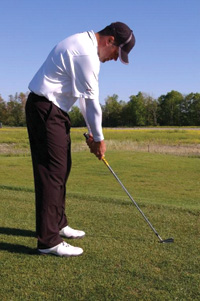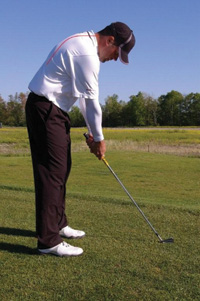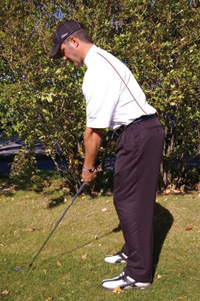
Features
Practice
Technique
Golf Injuries
Most therapists have encountered the phenomenon of the Upper Crossed Syndrome (UCS) previously, whether you have treated golfers or not. It is common to desk workers everywhere and anyone whose work is in front of them (which doesn’t exclude many of us!).
October 23, 2009 By Mark Elliott
Upper Crossed Syndrome happens to more than just duffers. Here is a complementary approach to addressing common golf injuries.
Most therapists have encountered the phenomenon of the Upper Crossed Syndrome (UCS) previously, whether you have treated golfers or not. It is common to desk workers everywhere and anyone whose work is in front of them (which doesn’t exclude many of us!). Posture that may begin efficiently soon deteriorates, with the head migrating forward. After a few days become weeks, and weeks become months, voila! Upper crossed syndrome rears its ugly head. (See Figure 1)
 |
|
|
UCS was first noted by physical therapist Vladimir Janda (whom we can also thank for Lower Crossed!). Let’s review the components of what he found with this prevalent condition. The muscles that are tight and shortened are usually Pectoralis Major and Minor, Upper Trapezius, Levator Scapulae, Latissimus Dorsi and Sternocleidomastoid. The muscles that are weak usually include Serratus Anterior and Lower Trapezius.
UCS leads to a forward head posture causing strain to the muscular attachments of the shoulder and shoulder blade. An anterior tilt and protraction of the scapulae occurs, producing a rounded shoulder appearance. Due to the rounded shoulder posture, the mechanical axis of rotation of the glenoid fossa becomes altered. The gleno-humeral complex now recruits additional stabilization from muscles that are typically less active. Postural overdevelopment of these muscles may lead to shoulder impingement, tendonitis and bursitis syndromes.
 |
|
| Figure 1. Anyone whose work is in front of them, including golfers, is susceptible to UCS. | |
 |
|
| Figure 2. With regard to golf, any excessive rounding of the upper back or thoracic spine is termed a “C-Posture”. | |
 |
|
| Figure 3. A more neutral posture is the key, but like any habit is easier learned in youth and must be maintained.
|
With regard to golf, any excessive rounding of the upper back or thoracic spine is termed a “C-Posture”. Put simply, the golfer looks like the letter “C” throughout the spinal column from the side profile (See Figure 2). “C” posture is essentially synonymous with UCS. This posture may be the result of a poor set-up position, but in my opinion activities of employment and daily living often reinforce the “C.” It is worth noting that the “C” can be developed by the archaic notion that the golfer should concentrate on keeping her head “down.” This injurious advice leads to increased thoracic kyphosis and cervical spine trigger points, pain, and high scores.
Neutrality the key
A more neutral posture (See Figure 3), where the lumbar region is slightly lordotic and the thoracic region presents with a gentle thoracic convexity is the aim for both consistent, healthier golf and everyday life. As with most muscle imbalances, UCS is usually perfected by practice and repetition! What was an alteration of “normal” posture as a youngster became the standard posture as an adult. As a therapist, changing the patient’s HABIT is the first step. I have always liked the idea of checking posture every time a person goes by a mirror – maybe a trifle vain, but it promotes a more neutral position.
Instructing the patient/golfer to stop “rounding” her shoulders or attempting to “straighten” her thoracic column will probably prove frustrating and fruitless. It can also be disastrous to her golf swing, as she will lose valuable speed by consciously attempting to alter the set-up position (the best golfers have the fewest swing thoughts). I have found that the best way to correct UCS/C posture is to address the limitations in the gym, complemented by soft tissue manipulation, if needed.
The most significant joint restriction seen over time in golf’s C-Posture is the lack of thoracic spine extension. It usually leads the golfer to experience a severe loss of thoracic spinal rotation, which limits his ability to create a good backswing turn (a critical element for consistency, safety and power). Consequently, the golfer will employ a “sway and slide” manoeuvre to swing away from and toward the target. These efforts place unneeded pressure on the entire spinal column’s soft tissue and joints. They also lead to inconsistent ball-striking, higher scores, further injury, slicing the golf ball, and fresh four letter words following the swing.
Treatment
With regard to initial clinical treatment, the muscular adhesions and trigger points that have developed must be addressed. This should be accomplished before active/passive stretching and concentrated resistance exercise. Failure to do so may result in stretch-reflex reciprocal inhibition and increased loss of muscle tone, furthering the progress of the UCS / C posture. Performing four to six sessions of myofascial release and trigger-point therapy usually is sufficient. The most commonly affected muscles are the aforementioned UCS muscles, rotator cuff, and scalenes.
Scapular retraction provided simply as an active movement (without resistance) is appropriate for self-care during the first stage of your treatment plan. This can be the building block for later re-training of the serratus anterior/posterior, trapezius and rhomboids, and restoring scapular stabilization strength.
Rotator cuff self-care should concentrate on external rotation so the subscapularis does not become tight and overdeveloped. External rotation is imperative in a golf swing. The right shoulder must have good range of motion in the backswing and the left shoulder, the same, in the forward swing (for a right-handed golfer). Initially, active free external range of motion will suffice, but this should be prescribed both in standing and golf postures in order to be functional for the golfer.
Repetition (changing the habit, which takes time!) and proper rest are also encouraged. In addition, the eager patient may employ a tennis ball on the affected tissues to promote the breaking up of trigger points. Self-employed myofascial release with foam rollers on the upper back, lower latissimus dorsi, teres major/minor and infraspinatus may accelerate healing and provide the patient with a greater sense of involvement.
This golfer will need lessons from a teaching professional, but I would encourage her to wait a few weeks. This will allow her to experience some health gains and be more comfortable with her “new” posture. Then the golf posture and swing can be cleaned up to prevent further injury.
Take care, and remember, in life and in golf, play the ball as it lies!
Mark Elliott, RMT, is a Level III golf teaching professional licensed through the Canadian Golf Teacher’s Federation and the United States Golf Teacher’s Federation. He is the only Canadian to be certified as a Level II Medical Professional and Level II Golf Professional of the Titleist Performance Institute (www.mytpi.com ). Mark has maintained a massage therapy practice in London, Ontario since 1996. He presently coaches players ranging from beginners to top amateurs. He can be reached with questions or concerns at (519) 495-3977 or mkelliott@rogers.com.
Print this page